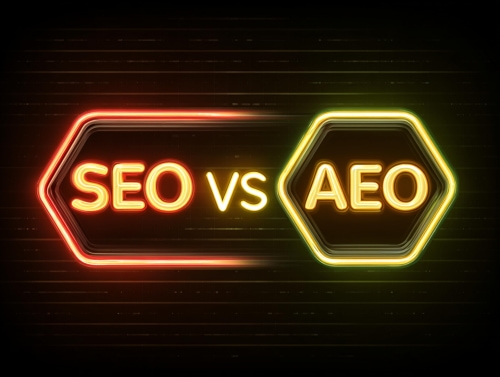SEO vs AEO: What the Rise of AI Search Means for Your Nonprofit Website


Want an engaging website?
As someone who has worked with hundreds of nonprofits on their website design, SEO strategy, and digital growth, I’ve seen firsthand how quickly online search is changing.
If you lead a nonprofit organization, you’ve likely noticed that tools like ChatGPT, Google’s AI Overviews, and Perplexity are transforming how people find information. Instead of relying solely on traditional search engines, users are now asking AI tools for answers — and getting them instantly.
This shift introduces a new layer of optimization: Answer Engine Optimization (AEO) — a complement to traditional Search Engine Optimization (SEO). Understanding both can help your nonprofit stay visible, attract supporters, and grow your online presence in an AI-driven world.
SEO for Nonprofit Websites: The Foundation of Visibility
Search Engine Optimization (SEO) has long been the foundation of nonprofit website design and digital marketing. It’s what ensures your website ranks well when someone searches for phrases like “nonprofits that fight hunger” or “volunteer opportunities near me.”
- It helps your organization reach more donors, volunteers, and community members.
- It drives traffic to your donation pages, blogs, and impact stories.
- It builds long-term visibility through keyword-rich, structured content.
Example: A nonprofit focused on clean water could write a blog titled “How Clean Water Impacts Child Health.” With strong SEO — including optimized headings, metadata, and relevant internal links — that post could rank on Google and bring in readers who care deeply about the cause.
What Is AEO — and Why It’s the Future of Search
Answer Engine Optimization (AEO) takes SEO a step further. Instead of just ranking on Google, AEO helps your content appear as part of the AI-generated answers people see in search results or chatbot responses.
If you’ve ever seen an AI summary or snippet that references a trusted source — that’s AEO in action.
For nonprofits, AEO means your organization can become part of the answer itself, not just one of many search results.
Example: If your website features up-to-date statistics on waterborne diseases, an AI tool responding to “Why is clean water important for children?” might cite your organization’s data — positioning your nonprofit as an authority in your field.
Why Nonprofits Should Care About Both SEO and AEO
At Morweb, we’ve helped nonprofits grow their visibility through a blend of smart web design, SEO best practices, and structured storytelling. But now, AEO is changing how credibility and authority are built online.
- Boost awareness: appear in both search results and AI answers.
- Increase donor trust: be recognized as a credible, quoted source.
- Maximize impact: ensure content performs across search and AI ecosystems.
It’s no longer enough to just get found — your nonprofit needs to get included.
Top 5 Best Practices for SEO and AEO on Nonprofit Websites
1. Create Content That Answers Real Questions
Think like your audience. What would a potential donor or volunteer ask Google or ChatGPT? Use those questions as your blog titles and headers.
Example: “How does clean water change children’s lives?”
2. Incorporate Mission-Focused Keywords
Focus on search phrases that connect to your cause and location, such as:
- “nonprofit website design for education organizations”
- “SEO for nonprofits”
- “digital marketing for nonprofit fundraising”
- “AI search and AEO strategies for nonprofits”
3. Use Data and Storytelling Together
AI tools favor factual information, while human readers connect with emotion. Combine both.
Example: Include statistics like “785 million people lack access to clean water” alongside a personal story of a family impacted by your nonprofit’s work.
4. Add Structured Data (Schema Markup)
Schema markup helps search engines and AI systems understand your content better. Use FAQ, HowTo, and Event schema on your pages to increase visibility.
5. Design Your Website for Both Humans and AI
SEO and AEO perform best on a technically sound, user-friendly website. Ensure your site:
- Loads quickly and is mobile-optimized
- Includes descriptive image alt text (e.g., “Children collecting clean water from a new well”)
- Ends with clear calls to action like “Donate Now” or “Get Involved”
How EEAT Principles Strengthen Your Nonprofit’s Online Authority
To succeed with SEO and AEO, your content must show E-E-A-T:
- Experience – Share firsthand impact stories.
- Expertise – Offer verified data and research.
- Authoritativeness – Reference credible sources (WHO, UNICEF, academic studies).
- Trustworthiness – Be transparent about mission, funding, and outcomes.
At Morweb, we design nonprofit websites that highlight these principles — building search visibility and donor confidence through strategic design and authentic storytelling.
Final Thoughts
The future of nonprofit website design and SEO isn’t just about ranking on Google — it’s about becoming a trusted voice in AI-driven search results.
By combining strong SEO foundations with Answer Engine Optimization and EEAT principles, your nonprofit can strengthen credibility, reach a wider audience, and amplify its mission online.
If you’re ready to enhance your nonprofit’s online visibility, start by optimizing your content for both people and AI — your mission will reach further than ever before.




